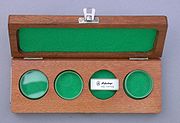
Optical flat
Encyclopedia

Glass
Glass is an amorphous solid material. Glasses are typically brittle and optically transparent.The most familiar type of glass, used for centuries in windows and drinking vessels, is soda-lime glass, composed of about 75% silica plus Na2O, CaO, and several minor additives...
lapped
Lapping
Lapping is a machining operation, in which two surfaces are rubbed together with an abrasive between them, by hand movement or by way of a machine.This can take two forms...
and polished
Polishing
Polishing is the process of creating a smooth and shiny surface by rubbing it or using a chemical action, leaving a surface with a significant specular reflection In some materials polishing is also able to reduce diffuse reflection to...
to be extremely flat on one or both sides, usually within a few millionths of an inch (about 25 nanometres). They are used with a monochromatic light to determine the flatness of other optical surfaces by interference. When an optical flat is placed on another surface and illuminated, the light waves reflect off both the bottom surface of the flat and the surface it is resting on. The reflected waves interfere, creating a pattern of interference fringes (Newton's rings
Newton's rings
The phenomenon of Newton's rings, named after Isaac Newton who first studied them in 1717, is an interference pattern caused by the reflection of light between two surfaces - a spherical surface and an adjacent flat surface...
), visible as light and dark bands. The spacing between the fringes is smaller where the gap is changing more rapidly, indicating a departure from flatness in one of the two surfaces, in a similar way to the contour lines on a map. A flat surface is indicated by a pattern of straight, parallel fringes with equal spacing, while other patterns indicate uneven surfaces. Two adjacent fringes indicate a difference in elevation of one-half wavelength
Wavelength
In physics, the wavelength of a sinusoidal wave is the spatial period of the wave—the distance over which the wave's shape repeats.It is usually determined by considering the distance between consecutive corresponding points of the same phase, such as crests, troughs, or zero crossings, and is a...
of the light used, so by counting the fringes differences in elevation of the surface can be measured to millionths of an inch.
Usually only one of the two surfaces is made optically flat to the specified tolerance, and this surface is indicated by an arrow on the edge of the glass.
Optical flats are sometimes given an optical coating
Optical coating
An optical coating is one or more thin layers of material deposited on an optical component such as a lens or mirror, which alters the way in which the optic reflects and transmits light. One type of optical coating is an antireflection coating, which reduces unwanted reflections from surfaces, and...
and used as precision mirror
Mirror
A mirror is an object that reflects light or sound in a way that preserves much of its original quality prior to its contact with the mirror. Some mirrors also filter out some wavelengths, while preserving other wavelengths in the reflection...
s for special purposes, such as in a Fabry–Pérot interferometer or laser cavity. Optical flats have uses in spectrophotometry
Spectrophotometry
In chemistry, spectrophotometry is the quantitative measurement of the reflection or transmission properties of a material as a function of wavelength...
as well.

